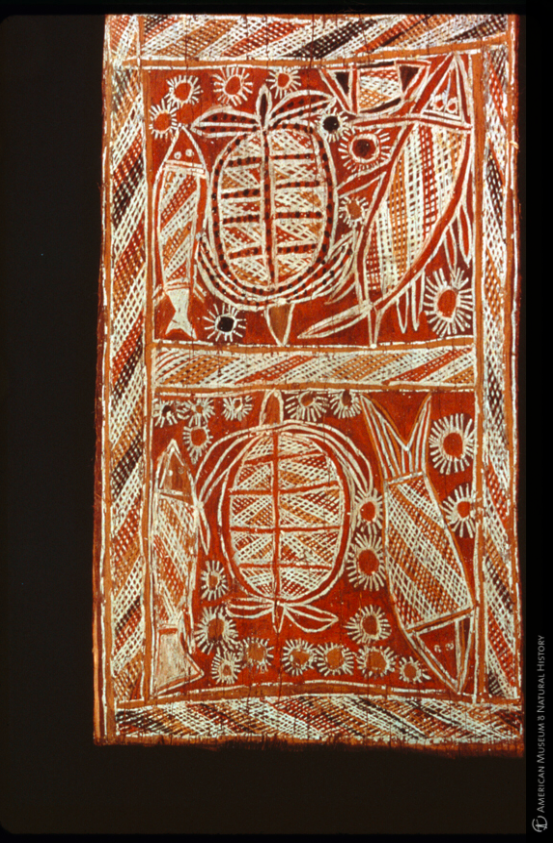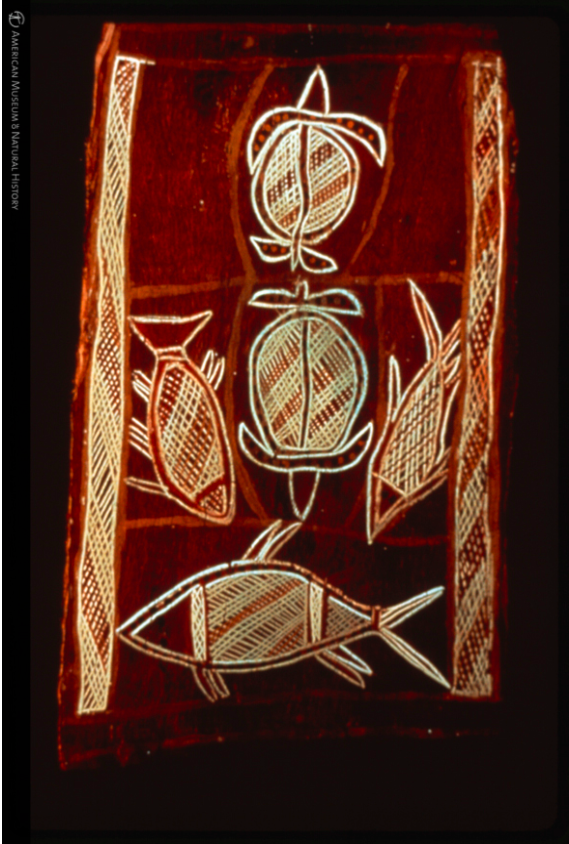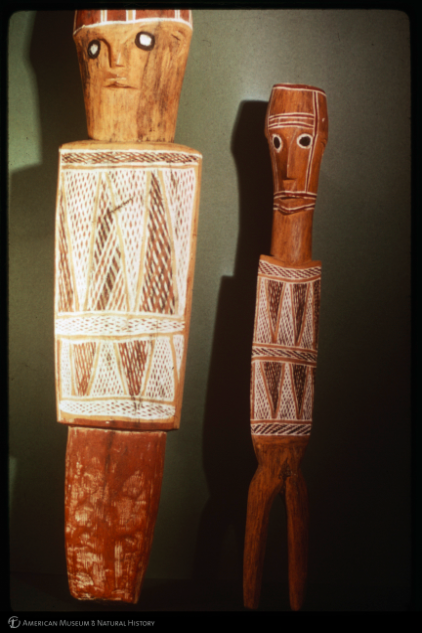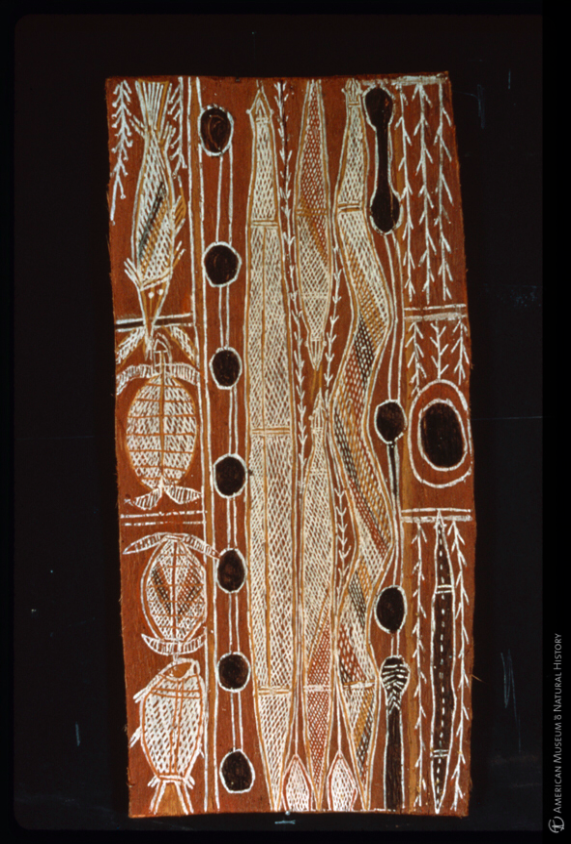Research Pathways
We began our search in the American Museum of Natural History’s Anthropology Collections Database using Sabra’s extensive list of almost 30 search terms.* Our initial search in the “Pacific” collection with the specification of “Australia” came back with 1,421 results. We further refined our search to materials from “Unidentified Cultures” in Australia which turned up over 700 results, all the while continuing to apply the list of search terms. We also searched in the museum’s archival databases, but for the most part, did not come up with anything useful that could be traced back to Ngukurr.
However, using the search terms “Arnhem Land” and “Roper River,” we were able to surface results in both the Digital Special Collections Database and Anthropology Collections Database. Ultimately, the content on this page is the result of our extensive research undertaken across various AMNH Digital Research Libraries and Collections Databases.
Objects from Arnhem Land
While searching in the AMNH’s Digital Special Collections Database, we were able to surface four objects labeled under the geographic location of “Arnhem Land — Northern Territory — Australia.” However, the date and creator were listed as unknown for each object, and we were unable to determine whether they are specifically from Ngukurr.

“Bark painting, fish and turtle designs” 
“Bark painting with animal designs, detail” 
“Painted wood figures” 
“Bark painting with animal designs”
We also spent time searching in the AMNH Anthropology Collections Database, using various search terms in an attempt to find objects from or somehow related to Ngukurr. Using the search term “Arnhem Land” we were able to surface a total of 130 objects, many of which were specifically listed under communities in Arnhem Land including, but not limited to Yirrkala, Elcho Island, and Oenpelli. Out of this selection of objects, we found one “Painting on Bark” (as seen on the right) listed generally under “Arnhem Land.”
Painting on Bark
Objects from Below Roper River
Our group uncovered twelve objects located Below Roper River, Karowa, in the AMNH’s Anthropology Collections Database. We have included five of them (representative of the entire collection) on this page, all of which are connected to the Spalding-Peterson Expedition (spelled incorrectly as “Spalding-Petersen” in the AMNH database) from the 1950s.
Initially, we were unable to find where Karowa is located. However, after hearing from Linguist Dr. Greg Dickson (March 3, 2021) about “Garrwa,” a language group in the Northern Territory, we did a bit more digging and found that it has multiple spellings, including “Karawa,” “Karrwa” and “Garawa” (2). Garrwa land spans about 6,300 miles, from east of the McArthur River in the Northern Territory to the Nicholson River in Queensland (3). Though the AMNH lists the locale of these objects as Below Roper River, Karowa (spelled with an ‘o’), it seems likely that “Garrwa” – or “Karawa” – is where the Spalding-Peterson expedition traveled and obtained the twelve objects.

This field catalogue (which contains notes on scientific organism names, sexes, dates, localities, and catalogue numbers) was written by Russell Peterson. From the locales listed, we see that this expedition visited towns and communities around Queensland and the Northern Territory, including Roper River Mission (now Ngukurr). Peterson mainly worked as a mammalogist and zoologist on this expedition, which is most likely why our group could not link any of our objects from Below Roper River to these notes specifically (4). Though we tried to find the full names of Spalding and other expedition participants, in hopes we could find and connect their notes, we had no luck. We are interested in whether a further deep dive into this expedition would yield more direct results to objects from Ngukurr and the cultural/anthropological aspects on which our project focuses; Curators at the AMNH may have relevant information and/or knowledge about the specifics of the expedition that could prove valuable to the aims of this project. Additionally, since we found a direct connection to Ngukurr in Peterson’s notes, a further investigation of mammalogy and zoology collections at the AMNH may be fruitful.
Pubic Cover
Another pubic cover can be found here: 4221
Hair Belt
Another hair belt can be found here: 4219
Citations
“AMNH Research Library: Digital Special Collections.” https://images.library.amnh.org/digital/index.php
“Collections Database: Anthropology.” https://anthro.amnh.org/collections
(1) “George Devereux.” In Wikipedia, December 7, 2020. https://en.wikipedia.org/w/index.php?title=George_Devereux&oldid=992925183, accessed February 25, 2021.
(2) Mushin, Ilana. “Previous linguistic work on Garrwa.” In A Grammar of (Western) Garrwa, 10. Berlin: De Gruyter Mouton, 2012. https://books.google.com/books?id=9Ah-vkNs2gAC&pg=PA5#v=onepage&q=karawa&f=false, accessed March 4, 2021
(3) “Garrwa People.” In Wikipedia, February 28, 2021, https://en.wikipedia.org/w/index.php?title=Garrwa_people&oldid=1009429711, accessed March 4, 2021.
(4) Peterson, Russell Francis. American Museum of Natural History, Spalding-Peterson Expedition: Field Catalogue (Australia, New Guinea), 1959. https://www.biodiversitylibrary.org/item/231643#page/2/mode/1up, accessed February 23, 2021.
We would like to be involved/included if possible, in future use of this material. Please contact this individual as point-person for our group: raohe22a@mtholyoke.edu